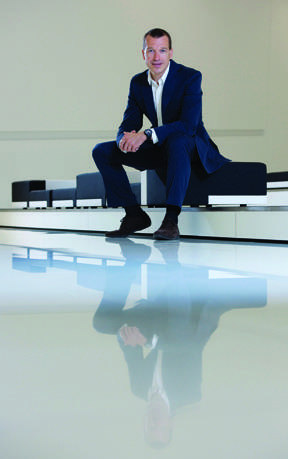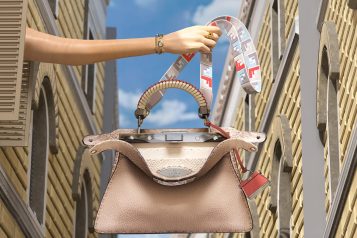“If you analyze the function of a product, its form often becomes obvious.” –Ferdinand Alexander Porsche
When a product carries a name like Porsche, it is surely destined to become an icon in its own right. It is common knowledge that the Porsche family lays claim to some of the most legendary automobiles throughout history—particularly the Porsche 911, designed by Ferdinand Alexander Porsche in 1963. It is by no coincidence that the designer of that very sports car—arguably the most influential sports car on the market—was the trailblazer for the Porsche Design Group.
Porsche Design CEO Dr. Juergen Gessler, an effortlessly chic and brilliant man, carries on this legacy of excellence. Much like Ferdinand Alexander Porsche, Gessler’s guiding principle is that iconic designs are not born from sleek looks, high cost, or even a family name—but from superior function as well as excellent form.
Making their designs innovative and in a word, different, is what Porsche Design Group is all about.
“What Porsche Design is doing, is creating for the customer,” Gessler said. “We always offer iconic style, but not just iconic style to make it iconic but also to be functional.”
Originally established by Ferdinand Alexander Porsche in 1972, Porsche Design is the ultimate luxury brand with a major focus in the technical function of each product. Porsche Design Group is now in its third season of designing high-end and stylish, yet supremely functional clothing, accessories and shoes. After the Porsche family decided to change the luxury auto company’s legal structure, thus pushing family members out of management, Ferdinand Alexander Porsche continued to pursue his love for practical invention and intricate design through a very different consumer avenue. He started with watches, then sunglasses, then small leather goods like briefcases and luggage. Eventually, the brand made an organic transition into fashion.
“The main reason was that he is a designer and always made products for himself, what he likes,” Gessler said of Ferdinand Alexander Porsche. “He likes watches, he likes sunglasses, briefcases—he made the products for himself. This was the intention. He was always passionate for the design.” Today, these very products are still the highlights of the brand’s modern line.
Since Porsche Design Group’s establishment, the products have embodied a marriage between superior design and function. The first product was, not surprisingly, a watch.
“Today it sounds not very spectacular,” Gessler said. “But this was the first black watch on the market ever.” And he’s right – until 1972, all watches were gold and silver, because they were meant to be jewelry; function wasn’t as highly regarded as beauty.
“[Ferdinand Alexander Porsche] said the function of a watch was to show the time and the best color codes to do so are white indicators on a black dashboard,” Gessler said. “So he started with the first watch, and then he did all the rest in black.” Ferdinand Alexander Porsche later pioneered the use of other unusual materials like titanium and aluminum in watchcases and bracelets. A watch made for both function and style sounds perfectly ingenious and truly moved the market at the time.
“It was a big hype—all the pilots, all the Formula One drivers bought this watch in the ‘70s,” Gessler said.
Porsche Design Group continued down the path of technicality. Next stop: sunglasses. The first Porsche Design eyewear in 1978 was a top-down process. They took the ultra-functional aviator form, founded by the U.S Government and produced by Ray-Ban, and made it fashionable. The Porsche sunglasses line is the most successful line in the world; the Porsche aviator was equally successful, creating a massive trend in the ‘80s. The brand has sold more than eight million pieces since its inception. It is trademarked by its flat design and the inclusion of two different lenses when purchased—the idea being that for functional reasons, customers like to have different shades depending on the weather and their clothing. Thus, the iconic drop-shaped lens eyewear can be purchased in unusual combinations—like a purple tinted lens with a gold frame. Although this product has suffered from widespread plagiarism, Porsche’s version remains the icon.
As the company grew, the designs diversified.
“If you look at Porsche Design, in a way it was always trying to offer people products to help them distinguish their personality. In the past, it was more watches and jewelry. Today, it is more in the fashion. If you look at people—women always, but now men, they style themselves. This is a challenge for many brands and Porsche Design Group tries to offer costumers products that do this,” Gessler said of Porsche Design Group’s modern design philosophy.
An example of this philosophy in action is the luxury brand’s leather jacket collection. According to Gessler, all the leather jackets on the market have a lining to help the material hold shape. Porsche Design Group—through laborious hand sewing of pieces on top of pieces of leather—offers the first leather jacket that holds a meticulous cut without a lining.
“We get a very purist jacket that is just leather,” Gessler said. “It’s very natural and to produce this is not easy; it is very unique on the market. It’s all made in Germany—all the jackets are—with outstanding technique.”
The same principle applied as Porsche Design started producing sneakers.
“We always find that if there is a market— a potential—Porsche Design thinks, ‘Can we make it different?’ and this was always Ferdinand Alexander Porsche’s approach. He always says if you analyze the function of the product, then the form sometimes becomes obvious,” said Gessler of the brand’s award-winning sneaker design. These designs are so popular that there is a wait list for each new design unveiled.
Making their designs innovative and in a word, different, is what Porsche Design Group is all about.
“This is always what [we are] thinking about – how can we improve the product design that is already used by the costumer?” Gessler said. For example, the so called Bounce:S sneakers are developed with a customer in mind. In this case it is a businessman, who can use the shoe for running in the morning for function, and wear it out for a beer that evening for style.
There are more than 125 Porsche Design retail stores in the world and counting. The brand is particularly popular in the Middle East and growing quickly in Asia. Porsche Design is in most major cities in the United States. This year, the brand launched its largest store in the world in New York’s SoHo neighborhood. But California is Porsche Design’s home base, Gessler said, with a retail presence in both Northern and Southern California since 1988.
With a purist philosophy founded on style and functionality, we have no doubt Porsche Design will only continue this growth.
“[Our philosophy] is to have style defined by the function,” Gessler said. “It should be iconic, always make an outstanding style, but it should not just be iconic because of the outstanding style. The design should have a reasonable function behind it. This is the way Porsche Design Group works.”






















